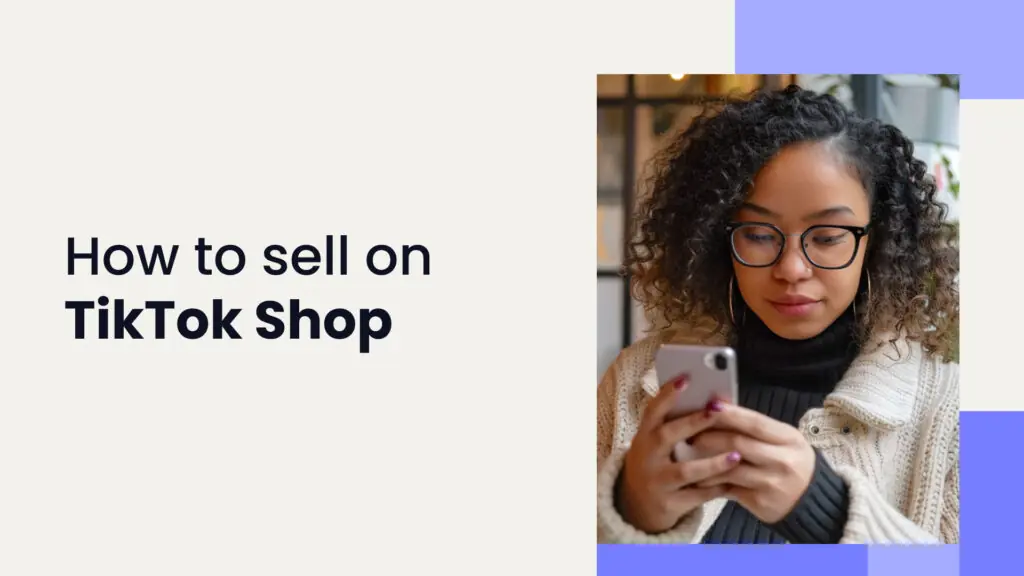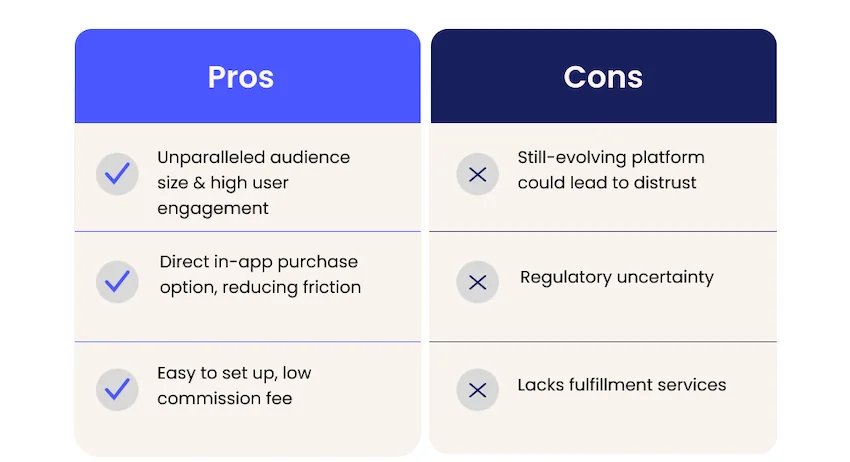Have you bought anything on TikTok shop? If you’re among the growing number of TikTok users, you’ve probably seen plenty of shopping content on your “For You” page. With the click of a button, TikTok users can now make purchases directly through the app. Selling and buying products online has never been easier.
Fund your inventory with 8fig!
The buzz surrounding TikTok Shop is evident through the widespread use of the hashtag #TikTokMadeMeBuyIt, which has garnered over 68 billion views. For eCommerce business owners and online sellers, this TikTok revolution is changing social commerce. But is TikTok Shop good for your business? Read on to learn more about TikTok Shop and how to start selling on the social media platform.
About TikTok Shop
With a over 1 billion active global users and counting, TikTok isn’t just a platfo rm for trending dance routines and lip-sync battles anymore. It’s evolving into a mammoth eCommerce market, changing the face of social commerce.
Social commerce, or the use of social networks to promote eCommerce sales, is growing quickly. TikTok Shop is the latest on the scene, providing a new, seamless way for sellers, creators, and affiliates to advertise and sell products directly through the app.
TikTok’s potential for eCommerce
Owned by the private Chinese conglomerate ByteDance, TikTok’s sophisticated algorithm does a terrific job of keeping users engaged for hours on end. It’s no secret that TikTok has a unique ability to continuously suggest content tailored to your interests. This leads people to lose track of time and get lost in the platform. The extended user engagement is the crux of TikTok’s massive potential for eCommerce.
TikTok Shop rollout
The app’s exponential growth and user engagement paved the way for the introduction of its eCommerce feature. TikTok started piloting it in the US in November 2022, after testing it out in the UK and several Southeast Asian countries.
Known as TikTok Shop, it allows users to make purchases directly within the app, saving the hustle of juggling between multiple apps or websites.
We’ll ask a few quick questions to better understand your specific business needs. Then, we’ll build a funding plan tailored to your expenses.
Subscribe to the eCommerce newsletter for
top industry insights
It’s worth noting that TikTok Shop is still in its early stages. However, the preliminary feedback seems promising with users appreciating the seamlessness of the shopping journey. And there are already viral TikTok products, such as the notorious pickle sweatshirt, which has made over a $1 million in sales through the app.
But TikTok Shop’s reception has been mixed, and it’s still not clear if the social commerce innovation will last. It failed to attract attract larger brands early on, and the looming possibility of a US TikTok ban can’t be ignored. And while TikTok Shop shines with potential, it’s no guaranteed success.
The world of social media eCommerce is unpredictable – as proven by Facebook’s decision to wind up its Live Shopping feature by October 1, 2022. Even Instagram, after experimenting with prominent placement of its social commerce feature, moved the shopping tab away from its home feed.
Reactions to TikTok Shop
The response to TikTok Shop is mixed. Initially, one of TikTok’s greatest draws was its genuine content created by users. Some fear the platform could now pivot more towards commerciality and lose its original essence.
What’s more, the ease with which sellers can list products on TikTok shop has some consumers worried. There have already been reports of scams and items that are never delivered. In addition, while TikTok claims to prohibit the sale of illicit items, many sellers have already found workarounds, and certain products such as diet pills are all too easy to access.
On the flip side, there’s enormous excitement about the business prospects. Sellers, affiliates, and creators alike are looking to TikTok shop for its potential to bring in revenue. In fact, TikTok is reportedly targeting a total of $20 billion or more in sales through the platform this year.
Might also interest you:
How to sell on TikTok
For entrepreneurs, brands, and creators looking to tap into TikTok’s vast and engaged audience, setting up shop on the platform is easy. Whether you’re a business owner, an established creator, a budding brand partner, or an affiliate looking to diversify, TikTok Shop is poised for eCommerce growth. Here’s how to get started on TikTok Shop.
- Set up a TikTok Business Account: If you don’t already have a TikTok business account, you’ll need to set one up to start selling on TikTok Shop. This account serves as the foundation for all your commercial activities on the platform.
- Register for TikTok Shop: Next, you’ll need to register for TikTok Shop. Sellers, creators, partners, and affiliates are all eligible to sign up. Provide your personal or business information, select which type of business you are registering, and submit the required documents. TikTok will review your application and, if everything is deemed satisfactory, send you an approval within 3 days.
- Link your account and bank: Once you receive the green light from TikTok, you can link your account to TikTok Shop. You’ll also need to link your bank account to the platform.
- Upload products and start selling! Once everything is set up, there’s nothing left to do but upload the products you wish to sell and start creating content. Tag your videos with your product and create as much content as possible. You never know when your product will go viral.
Ways to sell through TikTok Shop
TikTok Shop gives businesses and creators the ability to advertise and sell products directly through the app in a few different ways.
Shoppable videos
This feature transforms passive content consumption into an interactive shopping experience. Instead of just watching, users can tap on products they’re interested in and proceed to purchase without leaving the app. The power of shoppable videos lies in creating compelling narratives around products, seamlessly integrating storytelling with shopping.
Live shopping
Tapping into the live-stream trend, TikTok’s Live Shopping offers a dynamic real-time shopping experience. Sellers can actively engage with their audience, demo products, offer exclusive deals, and answer questions on the spot. This immediate interaction fosters trust and loyalty, bridging the impersonal gap often found in online shopping.
Product showcase
For a more structured approach, the Product Showcase offers a digital catalog where sellers can list their products with detailed descriptions and visuals. It allows users to leisurely browse and explore products of interest. The key is clarity and high-quality visuals, ensuring users are drawn into the offerings and can easily navigate through them.
Plan your restock accurately with 8fig
Should you sell on TikTok Shop?
The allure of TikTok Shop is undeniable. TikTok boasts a huge audience, putting your product in front of a massive number of potential customers. Moreover, what sets TikTok apart is not just its user base, but the level of engagement it garners. People aren’t just passive viewers; they’re actively interacting, so it’s more likely they’ll engage with your products too.
Yet another standout features is the ease of shopping. Customers can seamlessly transition from watching a video to purchasing a product, all without ever leaving the app. This streamlines the buyer’s journey.
However, since TikTok’s foray into eCommerce is still relatively new, they’re still figuring things out. This means there might be some initial challenges or changes as they tweak their system. Additionally, as more sellers recognize the potential of TikTok Shop, there’s a risk the platform could become oversaturated with sales content. In turn, this could potentially turn off users who crave the organic, fun content they initially signed up for. And of course, looming in the background are potential regulatory challenges, especially in the US, which could impact the platform’s trajectory.
TikTok charges sellers a commission fee, which varies by product and business. It’s worth noting that this fee is less than Amazon charges. However, remember that TikTok does not offer the fulfillment services available through Amazon, either.
Fund your inventory
One of the biggest challenges that successful online sellers face is making sure they have enough inventory to avoid selling out. Inventory procurement takes capital up front, and many eCommerce business owners therefore find themselves in a cash flow crunch, in need of a funding solution.
That’s where 8fig comes in. 8fig offers both the funding and cash flow management solutions you need to stay in stock. Plus, 8fig funding plans are flexible, so you can adjust them as your needs change. Find out how hundreds of eCommerce sellers have scaled their businesses thanks to 8fig and then sign up for a Growth Plan of your own.
Have article ideas, requests, or collaboration proposals? Reach out to us at editor@8fig.co – we’d love to hear from you.
Popular content
View articles




